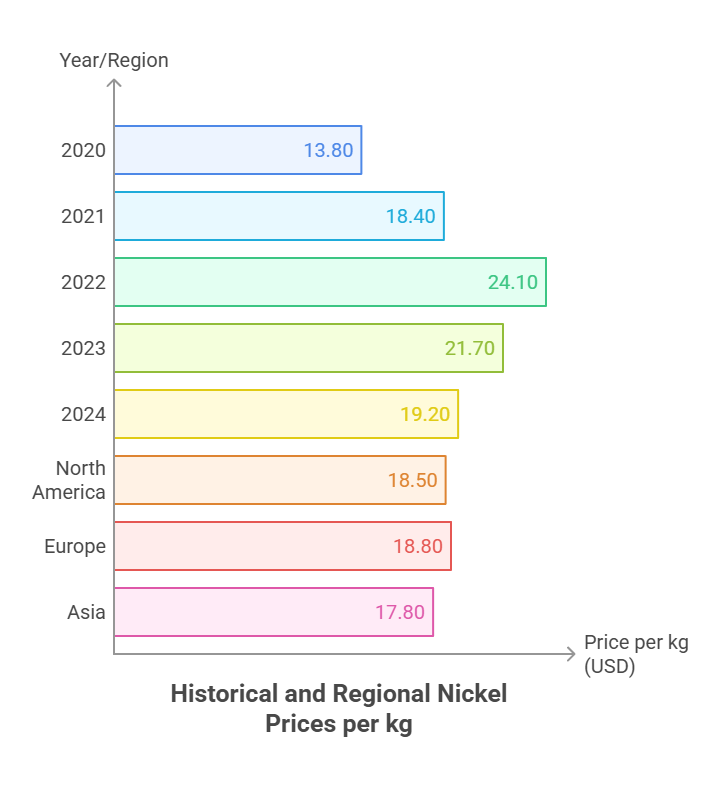Pure nickel is a critical industrial metal with widespread applications across aerospace, electronics, chemical processing, and battery manufacturing. Understanding its price per kilogram is essential for buyers and industry professionals making procurement decisions. This article offers a detailed breakdown of pure nickel prices per kg, including current market data, historical trends, global pricing differences, and factors affecting its cost.

Current Price of Pure Nickel per Kilogram
As of 2025, the average global price of pure nickel ranges from $18.00 to $20.00 per kg. This pricing is based on data from the London Metal Exchange (LME) and reflects the global average for high-purity nickel such as Nickel 200 or Nickel 201.
| Unit | Price Range (2025) | Conversion Basis |
|---|---|---|
| Per Metric Ton | $18,000 – $20,000 | 1,000 kg = 1 metric ton |
| Per Kilogram | $18.00 – $20.00 | Derived from LME spot prices |
| Per Pound | $8.16 – $9.07 | 1 kg = 2.20462 lbs |
Historical Price Trends per kg
The price of pure nickel per kilogram has shown substantial variation over recent years due to global economic factors, energy prices, and supply-demand dynamics.
| Year | Average Price per kg | Price per Metric Ton |
|---|---|---|
| 2020 | $13.80 | $13,800 |
| 2021 | $18.40 | $18,400 |
| 2022 | $24.10 | $24,100 |
| 2023 | $21.70 | $21,700 |
| 2024 | $19.20 | $19,200 |
Factors That Influence Nickel Price per kg
The price of pure nickel per kilogram is affected by multiple key factors that interact at both global and regional levels.
| Factor | Impact on Price |
|---|---|
| Supply from Major Producers | Indonesia, the Philippines, and Russia dominate global nickel mining. Disruptions increase prices. |
| Demand in EV Sector | Battery production for electric vehicles significantly boosts demand and price. |
| Market Speculation | Traders and hedge funds can influence LME pricing, affecting short-term costs per kg. |
| Energy Costs | Higher energy costs drive up mining and refining expenses, increasing the per-kg price. |
| Environmental Policies | Carbon taxes and emissions regulations in mining countries can raise operational costs. |
Regional Price Differences (per kg)
Nickel prices can vary by region due to transport, import tariffs, and local demand dynamics. Below is a comparison of typical per-kg pricing in 2025 across different markets.
| Region | Average Price (USD/kg) | Remarks |
|---|---|---|
| North America | $18.50 – $20.20 | Includes domestic shipping & warehousing |
| Europe | $18.80 – $20.50 | Higher due to energy and labor costs |
| Asia | $17.80 – $19.60 | Closer to source markets like Indonesia |
Nickel Form and Grade Pricing per kg
Different forms and grades of pure nickel have different price points depending on processing and intended use.
| Product Form | Typical Grade | Price Range (USD/kg) |
|---|---|---|
| Nickel Plate | Nickel 200 | $18.20 – $20.80 |
| Nickel Rod | Nickel 201 | $18.40 – $21.00 |
| Nickel Sheet | Nickel 200 | $18.00 – $20.50 |
| Nickel Wire | Nickel 201 | $18.80 – $21.20 |
Forecast: Where Will Prices Go?
Analysts forecast that nickel prices may increase moderately over the next few years, potentially reaching up to $22.00/kg by 2027. This is driven by:
– Increasing EV battery production, particularly in North America and China
– Limited new nickel mining projects entering the market
– Political uncertainty in key producing nations
Related Questions
How much is 1 kg of pure nickel worth?
As of 2025, 1 kg of pure nickel is worth between $18.00 and $20.00 depending on grade, form, and region.
Is pure nickel expensive?
Yes, pure nickel is considered expensive due to its critical industrial applications and limited global production capacity.
What is the price difference between nickel 200 and nickel 201?
Nickel 201 (lower carbon content) is slightly more expensive, typically by $0.20–$0.40 per kg, due to better performance in high-temperature environments.



